Cocaine binds to a common site on open and inactivated human heart (Na(v)1.5) sodium channels
- PMID: 12068034
- PMCID: PMC2290378
- DOI: 10.1113/jphysiol.2001.016139
Cocaine binds to a common site on open and inactivated human heart (Na(v)1.5) sodium channels
Abstract
The inhibition by cocaine of the human heart Na+ channel (Na(v)1.5) heterologously expressed in Xenopus oocytes was investigated. Cocaine produced little tonic block of the resting channels but induced a characteristic, use-dependent inhibition during rapid, repetitive stimulation, suggesting that the drug preferentially binds to the open or inactivated states of the channel. To investigate further the state dependence, depolarizing pulses were used to inactivate the channels and promote cocaine binding. Cocaine produced a slow, concentration-dependent inhibition of inactivated channels, which had an apparent K(D) of 3.4 microM. Mutations of the interdomain III-IV linker that remove fast inactivation selectively abolished this high-affinity component of cocaine inhibition, which appeared to be linked to the fast inactivation of the channels. A rapid component of cocaine inhibition persisted in the inactivation-deficient mutant that was enhanced by depolarization and was sensitive to changes in the concentration of external Na+, properties that are consistent with a pore-blocking mechanism. Cocaine induced a use-dependent inhibition of the non-inactivating mutant and delayed the repriming at hyperpolarized voltages, indicating that the drug slowly dissociated when the channels were closed. Mutation of a conserved aromatic residue (Y1767) of the D4S6 segment weakened both the inactivation-dependent and the pore-blocking components of the cocaine inhibition. The data indicate that cocaine binds to a common site located within the internal vestibule and inhibits cardiac Na+ channels by blocking the pore and by stabilizing the channels in an inactivated state.
Figures
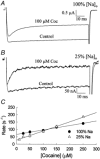
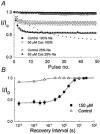
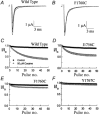
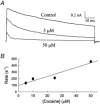
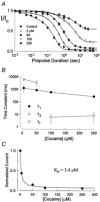

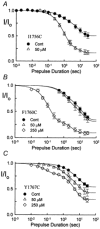
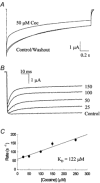
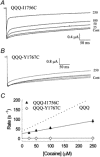
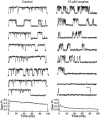
Similar articles
-
Closing and inactivation potentiate the cocaethylene inhibition of cardiac sodium channels by distinct mechanisms.Mol Pharmacol. 2003 Dec;64(6):1575-85. doi: 10.1124/mol.64.6.1575. Mol Pharmacol. 2003. PMID: 14645689
-
State-dependent trapping of flecainide in the cardiac sodium channel.J Physiol. 2004 Oct 1;560(Pt 1):37-49. doi: 10.1113/jphysiol.2004.065003. Epub 2004 Jul 22. J Physiol. 2004. PMID: 15272045 Free PMC article.
-
Functional consequences of lidocaine binding to slow-inactivated sodium channels.J Gen Physiol. 1996 May;107(5):643-58. doi: 10.1085/jgp.107.5.643. J Gen Physiol. 1996. PMID: 8740377 Free PMC article.
-
Interactions of local anesthetics with voltage-gated Na+ channels.J Membr Biol. 2004 Sep 1;201(1):1-8. doi: 10.1007/s00232-004-0702-y. J Membr Biol. 2004. PMID: 15635807 Review.
-
Molecular mechanisms of local anesthesia: a review.Anesthesiology. 1990 Apr;72(4):711-34. doi: 10.1097/00000542-199004000-00022. Anesthesiology. 1990. PMID: 2157353 Review.
Cited by
-
Differential effects of cocaine on dopamine neuron firing in awake and anesthetized rats.Neuropsychopharmacology. 2012 Jun;37(7):1559-71. doi: 10.1038/npp.2011.339. Epub 2012 Feb 1. Neuropsychopharmacology. 2012. PMID: 22298123 Free PMC article.
-
Fast- or slow-inactivated state preference of Na+ channel inhibitors: a simulation and experimental study.PLoS Comput Biol. 2010 Jun 17;6(6):e1000818. doi: 10.1371/journal.pcbi.1000818. PLoS Comput Biol. 2010. PMID: 20585544 Free PMC article.
-
Cocaine Exposure Increases Blood Pressure and Aortic Stiffness via the miR-30c-5p-Malic Enzyme 1-Reactive Oxygen Species Pathway.Hypertension. 2018 Apr;71(4):752-760. doi: 10.1161/HYPERTENSIONAHA.117.10213. Epub 2018 Feb 26. Hypertension. 2018. PMID: 29483230 Free PMC article.
-
A Literature Review of the Use of Sodium Bicarbonate for the Treatment of QRS Widening.J Med Toxicol. 2016 Mar;12(1):121-9. doi: 10.1007/s13181-015-0483-y. J Med Toxicol. 2016. PMID: 26159649 Free PMC article. Review.
-
An inactivation stabilizer of the Na+ channel acts as an opportunistic pore blocker modulated by external Na+.J Gen Physiol. 2005 May;125(5):465-81. doi: 10.1085/jgp.200409156. Epub 2005 Apr 11. J Gen Physiol. 2005. PMID: 15824190 Free PMC article.
References
-
- Alpert LA, Fozzard HA, Hanck DA, Makielski JC. Is there a second external lidocaine binding site on mammalian cardiac cells? American Journal of Physiology. 1989;257:H79–84. - PubMed
-
- Bennett PB, Valenzuela C, Chen LQ, Kallen RG. On the molecular nature of the lidocaine receptor of cardiac Na+ channels. Modification of block by alterations in the alpha-subunit III-IV interdomain. Circulation Research. 1995;77:584–592. - PubMed
-
- Billman GE. Cocaine: a review of its toxic actions on cardiac function. Critical Review of Toxicology. 1995;25:113–132. - PubMed
Publication types
MeSH terms
Substances
Grants and funding
LinkOut - more resources
Full Text Sources
Miscellaneous

